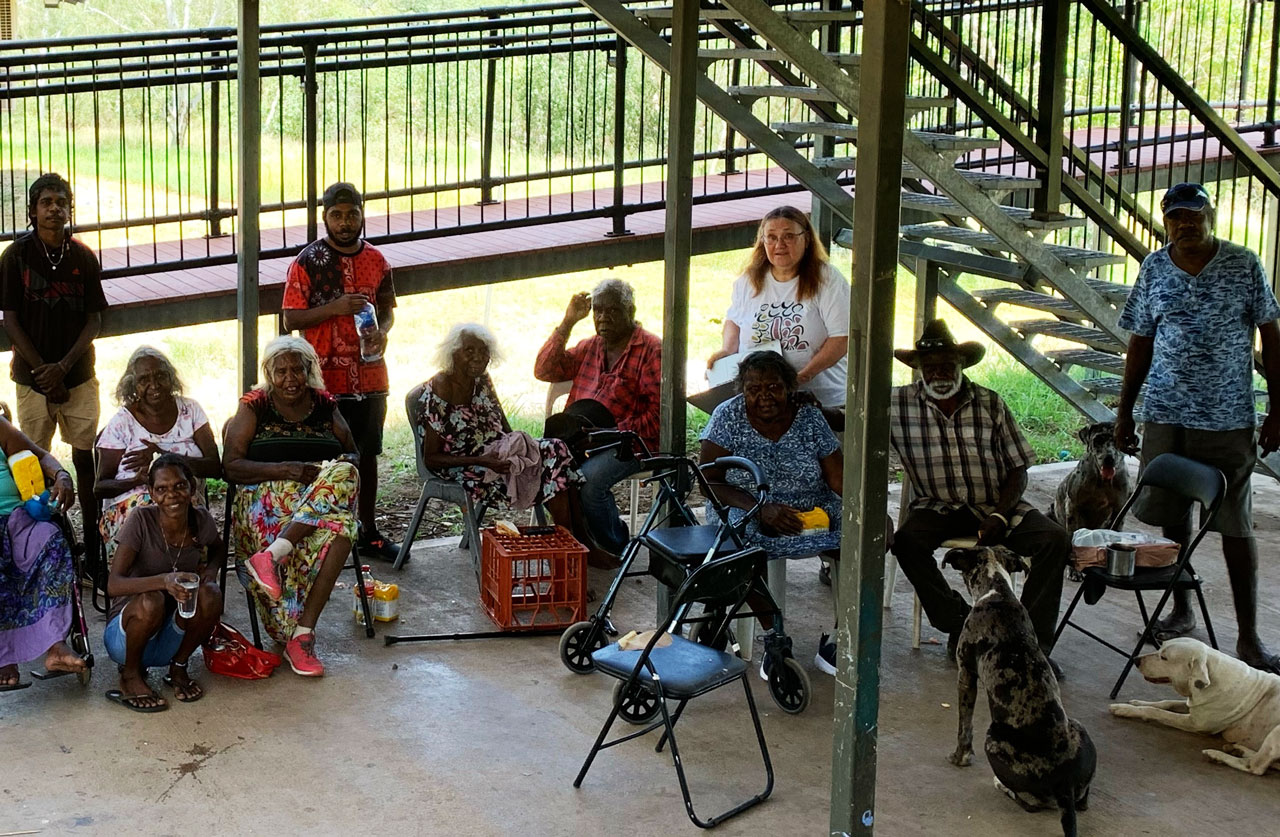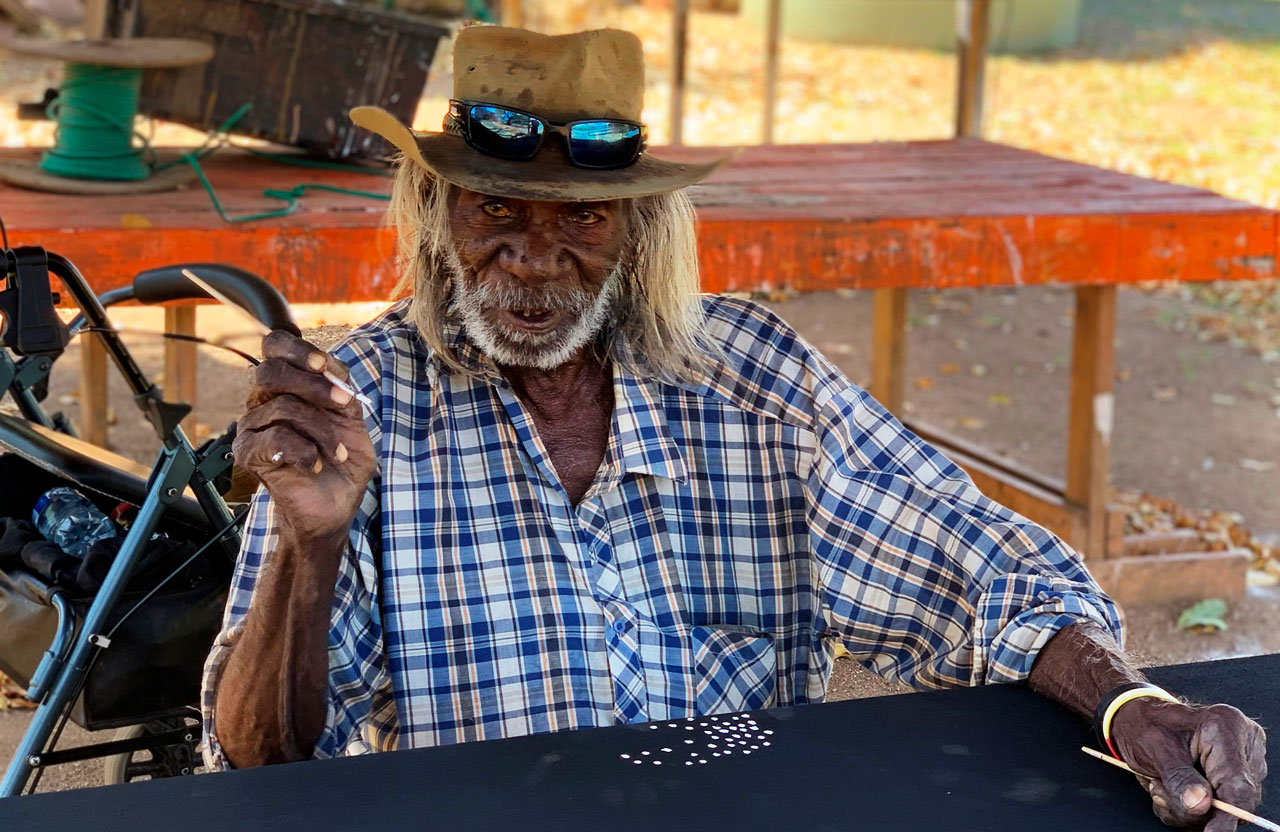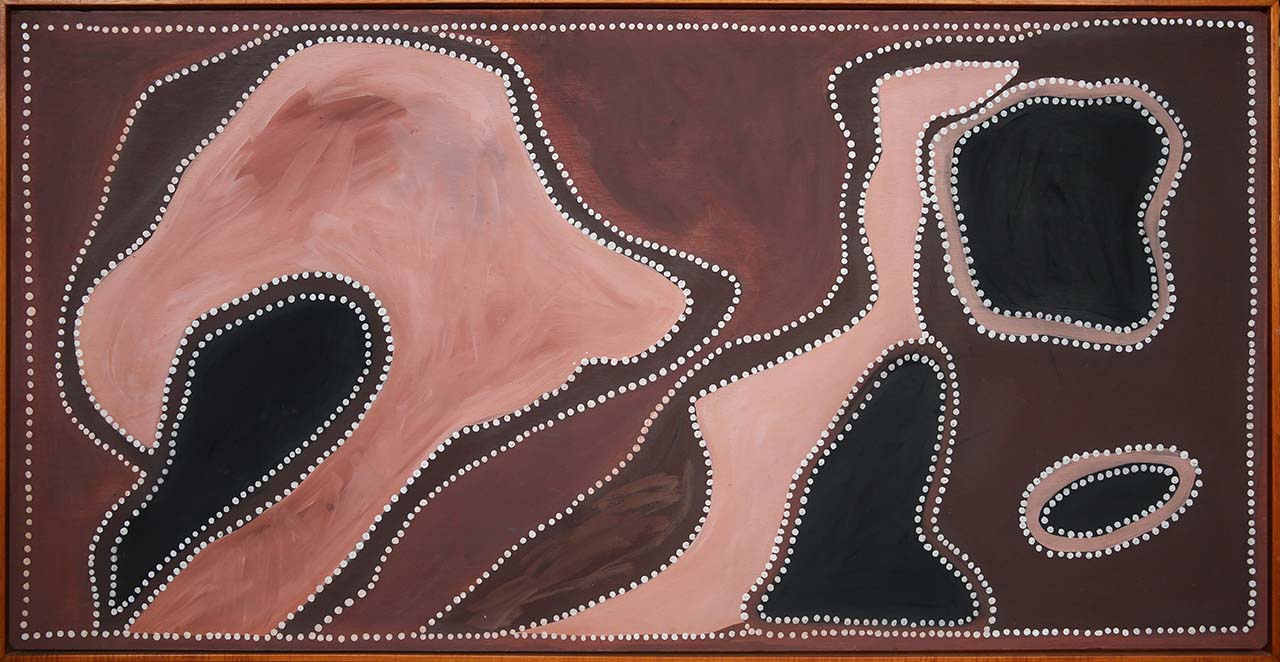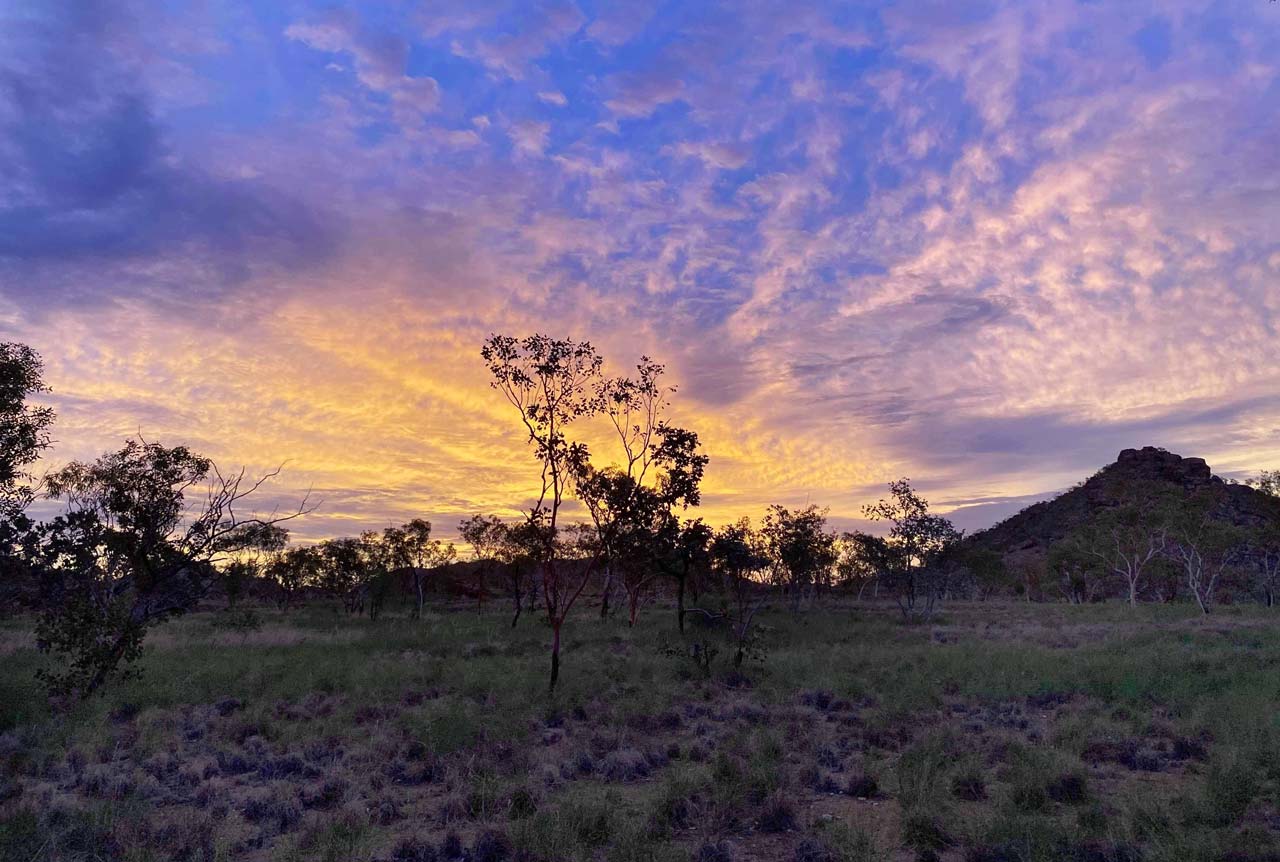Ochre Painting By Warmun Artists
Dominic Kavanagh is the Gallery Coordinator at Warmun Art Centre. In this interview Dominic talks about the art centre, the artists and the ochre medium, the Warmun art style and how he came to take up the role of Gallery Coordinator. Works from Warmun Art Centre will feature in a new exhibition at Japingka Gallery this July.
The Art Centre
How do you describe the Warmun Art Centre?
Warmun Art Centre is located in Gija country in the East Kimberley of Western Australia. It is surrounded by the tall spear grass and red earth and rocks of the Kimberley. It's a very beautiful landscape. Temperatures regularly reach 45 degrees plus throughout the summer. Although inspiring, it is a difficult place to live and this influences the nature of the artists out here. The people tend to be resilient and tough. Their work, lives and stories reflect that spirit.
How many artists do you have working through the art centre?
We’ve had 70 artists who have made work here over the past 12 months. That's not to say that they're all making a hundred works a year. Sometimes an artist might only make one work because they're just coming through and being part of one of our programmes.
Is there a typical routine at the art centre?
There's no such thing as a typical routine. It is diverse, challenging and exciting, which is what makes it such a brilliant place to work.
We've got an amazing group of studio workers who work stretching our canvases every day and packing up artworks that have been sold. We've also got a dedicated team of arts workers who work in the gallery, making the sales, answering the phones, making sure that our artworks are catalogued appropriately. We have our senior elders and artists who come in and meet, sit down, share a cup of tea, have a yarn.
Every Tuesday we have a meeting when our artists, arts workers and studio workers all come together. Those gatherings have happened for the last 22 years. It is the most routine thing about the art centre, and the other constant is our phenomenal team of dedicated Gija workers.
The studio and the art gallery must have the best view of any art location in Australia.
Exactly! But sometimes you forget that you're in this incredible location and so we regularly go out on to country. In fact, one of our programmes is Connecting with Country.
We take the artists, both senior and junior, and our arts workers and our staff out on to Gija Country. This gives us all the opportunity to remember that we're in one of the most gorgeous locations in the world. You can see it in the artwork that's created after these visits. People seem to feel more deeply rooted, more deeply connected to their works.
The Artists
What medium do the artists use?
Most artists who work with us predominantly use ochre. The ochre pigment is mined from the earth and brought to the art centre. It's crushed up into a fine powder then mixed with water and a PVA fixative. This makes the medium that you see on our canvases. The artworks are made on Gija country, very often telling stories about the landscape and painted with ochre from that country, literally works made on Country, with Country, about Country.
What do the artists paint about?
It is a very connected artistic practice. It is deeply rooted in Gija culture and history. A lot of our artists tell stories of the Ngarranggarni, the ancient Dreamtime, either of the animals, landscape or people. These form the narratives of the region. The art is rich in these stories and histories.
The artists paint the landscape, so important for the survival of culture and people. They paint about the history of the place. Often the history is rich and exciting and successful, but it can also be about events that were heartbreaking and tragic. There are massacre stories which are told in some of the paintings. That kind of trauma is very difficult for our artists to engage with, but it's also very important to remember what our artists and their ancestors have been through.
Ochre As A Medium
Do various artists use the ochre pigments differently?
I would say that 90% of our artists use ochre pigments and a small number that use acrylic pigments. A new generation of artists are mixing the two together. They will use acrylic pigments mixed in with the ochre so you get these vivid, bright blues or oranges which still have that tactile surface appearance of the ochre. These artists are doing that as a nod to their past, but also just working in with a new palette and working with an eye to the future.
A lot of our older generation of artists will use the ochre exclusively, but they also use charcoal to achieve the really rich blacks that come through in a lot of the artworks.
Is it hard to get a good supply of the ochres?
We've got a huge store of ochre here at the art centre. We're lucky that previous art centre managers have worked well with the local community to build up that stock. I've been here for 12 months and we haven't needed to renew those ochre stores at all.
The Kimberley is resource rich. Close to us there's a nickel mine, an iron ore mine, and a diamond mine. We are very fortunate to have some good relationships with the resource companies in this area. If they find deposits of ochre, these will often be given to the art centre which is something we really appreciate.
Our artists also have deep local knowledge of the region. Elders will know exactly where to go to mine ochre, and while they might not be strong enough to wield the shovel anymore, they can take one of the young arts workers and mine that ochre on country themselves.
The Warmun Style
Warmun art has always had a very distinct quality and look in the art world. Can you give us your feeling about that?
I think the most distinctive thing about Warmun art is the use of ochres and flat planes of colour and that was really brought about by the late, great Rover Thomas. Rover was not a Gija man himself but he came here from his home in the Great Sandy Desert. He brought a commitment to artistic excellence to Warmun. At the same time he was guided by some of the artists who were already living here, people like Paddy Jaminji and George Mung Mung. These Gija elders gave Rover the tools he used to create his incredible work.
Rover Thomas is the most famous artist to have worked from Warmun. We're lucky to have an example of his work in our petrol station on a painted wall. Rover painted an owl and Serpent Dreaming story. He fostered this tradition of using ochre, using flat areas of colour delineated by lines of dotting, and that's the East Kimberley style which can be seen in Warmun and can be seen throughout the East Kimberley today.
The strong artistic tradition is also informed by all of the cultural custodianship and cultural preservation which is done through the arts centre. That occurs with Joonba, which is the Gija word for corroboree. Cultural ceremonies occur on a regular basis and are co-ordinated by the art centre. There's also language lessons at the art centre and local school to keep the Gija language strong. The community members are keen to preserve Gija language and pass it on to future generations.
Dance is also part of the local culture. It is primarily associated with our Joonba Corroboree programme. I think all of these facets of Gija culture are brought together at this nexus point, which is the art centre. It all helps to preserve and celebrate Gija culture for the next generation.
The Artists and COVID
What gives the artists the most joy during the year?
I think the artists are the happiest when they're out on country. I don't think it matters if it's the wet season, if it's the dry season, I think it's just being out on country and connecting to their traditional homelands that gives the artists the greatest joy.
One of the most interesting things about the COVID pandemic was that a lot of artists left Warmun to go back to their traditional homeland as a means of safeguarding their health. We've got an incredibly fragile community out here in Warmun. It would have been devastating if the virus was to reach our community. They went back out of their homeland and were thrilled to be there and came back refreshed and reinvigorated.
Gallery Co-ordinator
What is your background before you became the Art Gallery Co-ordinator at Warmun?
I studied fine arts in Sydney with a major interest in photography before I decided to focus on curating. I started out in a role as assistant curator at the Museum of Contemporary Art. One of the very first shows that I worked on was with their chief curator Rachel Kent. It was called Telling Tales: Excursions in Narrative Form. Four of the artists in that group exhibition were from the Warmun Art Centre.
We had the amazing late Phyllis Thomas from Crocodile Hole, Mabel Juli, with her ‘Garnkiny Ngarranggarni’ Moon Dreaming Stories, Peggy Patrick with her ‘Marlam, Marlam’ boards, and we also had Shirley Purdie with her incredible 72 panel series ‘Goowoolem Gijam’. I thought the work that these women were doing at this time in a remote pocket of North West Australia was astounding. Really unfathomably brilliant. I really wanted to work with them.
In 2019 I saw this position as Gallery Co-ordinator of the Warmun Art Centre and I've been in Warmun for the last 12 months.
What gives you the most satisfaction in your work?
I think the most satisfaction in my work comes from watching the artists paint. The artists have such knowledge and connection to their country and to their stories and history. To see them paint you can see that it is just second nature to them. It's something that's deeply embedded within them. To see that knowledge passed on through the medium of artistic production and to hear those stories is a real privilege.
The Big Wet Season
Can you give us your impressions of the wet season?
The wet season in Gija country is remarkable. The landscape completely changes. I arrived in Warmun in June and I didn't see a cloud in the sky until November. The wind and storms started and the lightning and the thunder and rain came. The waterways started to come alive. Dry creek beds become torrents and rivers cutting through the country and dividing it.
The Kimberley can seem like a very harsh place because it can be so dry and so unforgiving, but during that wet season it becomes so green and so lush and there's so much animal life, and so many people will go out fishing and camping and hunting because the country just does become so vibrant.
I would often skive off work just so I could go fishing or swimming because the rivers and waterways would be bursting with life. There is such a sense of community as half of everybody who lives in Warmun could be down by the riverbank swimming and fishing; cooking their black bream on open fires.




